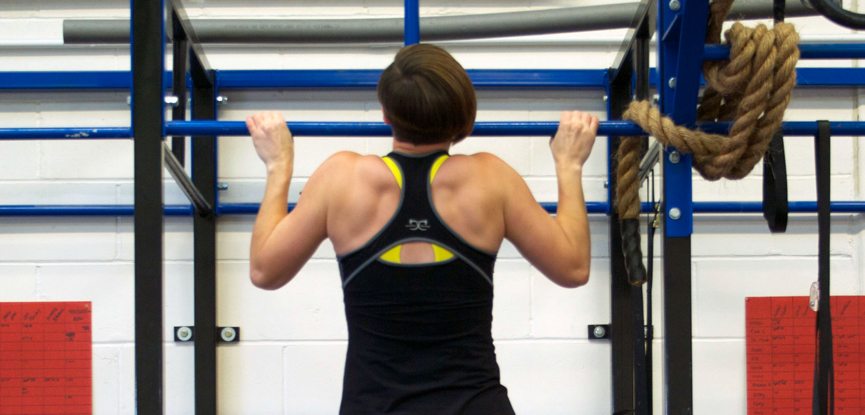The CrossFit benchmark workouts are named after women, much like the typical naming convention of storms. According to Greg Glassman, the founder of CrossFit, “anything that leaves you laying on your back gasping for air wondering what just happened to you should be named after a girl.” You’ll often hear people talking about their Fran time, or how they tackled the “three bars of death”. But what are the best benchmark WODs to take on, and just how do you tackle them? I’m going to pick my top 5 girls, and give you some efficiency tips along the way… so buckle up your weightlifting belts, you’re in for a treat.
Fran
21-15-9 reps for time:
- Thruster 95 lbs*
- Pull-ups
*A front squat with an overhead press
Note: women’s RX for each of these workouts is 2/3 of the men’s RX.**
**RX simply means as prescribed

One of the original six girls, Fran is a pair of thrusters and pullups to devastate your lungs and leave you wondering what your name is. The 21-15-9 rep structure may look easy at first, but this workout is a sprint and the thrusters get hard, quick. The best times are just over 2 minutes, and you really shouldn’t be taking any longer than 5 or you’re not working to the goals of the workout. This is one where you really should scale if you’re not strong at both movements.
Let’s Talk Tactics
Unbroken?
The elite will do each set of each exercise unbroken, making everything look effortless as they always do, and in an ideal world, you’d do the same. But the reality is you may need to break the reps up into manageable chunks to allow you breathing room. Don’t take too long resting though, just long enough to shake out your arms/legs and start again. Personally, if I’m going to break I like to split the work into rough halves, i.e. the 21 reps go into an 11 and then a 10.
Psychologically it helps to get the bigger chunk done first and then what’s left doesn’t seem too bad. I would then do the same for the 15, i.e. do a set of 8 and then 7, and try to do the last round unbroken.
Standards
The key to both movements is efficiency – get your technique really spot on and your reps will be easier, meaning you can break less. Simple. Finally, be clear with your movements and be strict with yourself – in this kind of workout, where speed is of the essence, you definitely don’t want to be no-repped! So get that butt below parallel and your head through the “window” in the thrusters, and get your chin above the bar on those pullups. No excuses.
Feel the Pain
Having said all of that, Fran is really all about pushing through the pain* and getting it done. Keep yourself focused on the task at hand and break your rest sooner than you’d like to… it’ll be over soon!
*Obviously I’m referring to the discomfort of working hard, not actual physical injury here!
Grace
30 reps for time:
- Clean and Jerk 135 lbs
Another fast WOD, Grace is a different test, this time more of technique than pure grit. To perform fairly heavy Olympic lifts that many times takes a coolness of character and an ability to lift proficiently. Every. Single. Time. The best times for this WOD are just over a minute, and up to 3-4 mins is still really good!

Let’s Talk Tactics
Pacing
To tackle this WOD you’ll need to pace well from the start. If you’ve ever watched Rich Froning taking on heavy Grace (at 225lbs instead of the RX of 135lbs) you’ll notice that he starts out with singles from the very first rep, takes a few steps back and then returns to the bar to reset. This is a sensible tactic for those taking on Grace (or Isabel) for the first time so you can get a feel for the workout. Keeping composed is key to getting this workout done as going hell for leather straight away could just mean taking longer recovery towards the latter stages of the reps… slow and steady wins the race!
The Bar
Rest your grip. Unless you’re aiming to finish in 2 minutes or under you really don’t need to be doing touch and go reps. Your grip is likely to be one of the first things to go, so rest it early by dropping the bar (if it’s safe to do so) rather than holding on to the bar for longer than necessary. Don’t re-adjust the bar. It’s common to want to keep the bar in a certain line before each lift, especially when on a platform. But, unless the bar position is an obvious hazard, it’s just a waste of energy moving it back to your preferred position. It’s much more efficient to move yourself to the bar to get your optimal lifting start point than it is to move the bar to you.
Power It Up
Power clean, if you can. Besides grip, the main issue you’ll face is a breakdown in technique. Technique issues will mean failed attempts through not pulling high enough, and you’ll want to pull high because it’s far more efficient to power clean than it is to drop underneath it every time.
Karen
For time:
- Wall ball 150 shots
Wall balls… everyone loves wall balls. Or not. They may seem harmless, but this simple exercise becomes taxing really quickly and is not to be underestimated so while this WOD may seem basic, it’s a great challenge. You’ll work on your mental strength as you break down the high volume of reps, as well as developing cardiovascular function, leg and shoulder strength and endurance, accuracy and precision.

Let’s Talk Tactics
Resting
This workout 100% needs a strategy of some sort. You WILL need to break the reps up and it’s better to do this in a methodical way so you can keep count and have small breaks to look forward to. How many reps you do per set is entirely up to you, and is by no means fixed. Some like to do sets of 10, others 20. The real key to this workout is how, and how long, you rest. Instead of dropping the ball to the floor, rest it against the wall, supporting it with your body. This will allow your arms a rest but saves you having to bend to pick it up again before starting the next set – just grab it and sit into your squat to start the rep. Try not to rest for longer than a couple of breaths or you’ll add significant time with the number of sets you’re likely to do.
Be Accurate
Finally, keep accurate. There’s no use throwing the ball far higher than it needs to go, similarly, you don’t want to be undershooting or going to the side. If you aim for the same spot on the wall or target every time you won’t need to readjust or catch the ball at a funny angle as it returns. Once you get into a rhythm it’s these sorts of things that lead to no reps, and when you’re already doing 150 reps you really don’t want to be repeating any!
Nancy
Five rounds for time:
- 400-metre run
- Overhead squat 95 lbs (15 reps)
This workout is a little bit Jekyll and Hyde. You have the all-out speed of the run, super-setted with a movement that requires focus and control. Overhead squats are a challenge for a lot of people – they challenge your flexibility, coordination, strength and stability in one straightforward movement – and running seems to be a lot of CrossFitters’ nemesis.

Let’s Talk Tactics
Pacing
The first round should be completed at a comfortable pace, especially the run, as going out too fast could really mess up your game for the rest of the workout. Running all out will make your breathing heavy, and lactic acid starts to build up, making stability in those squats a nightmare and once you start to fail reps you’ll lose valuable time… all for not much gain on the run. Unbroken? The weight is fairly light for the strong legs, but if you have to break it up then, of course, do.
If you have to break the reps up to more than two sets per round then it’s probably worth scaling to a weight you can manage unbroken or in two sets – the time it takes to put the bar down and get it back up again eats away at your workout too much for such low rep volume. You can get the bar up anyhow you like, but snatching will be the most efficient, especially because you’ll probably want to squat with a wide grip anyway. Other options include cleaning the bar up, then widening your grip before pressing out. Although you have to question, if you can’t snatch the weight, should you be overhead squatting it for 5 rounds of 15?
Linda
10-9-8-7-6-5-4-3-2-1 for time:
- Clean 3/4 bodyweight
- Bench bodyweight
- Deadlift 1 1/2 bodyweight
Oh Linda, aka “the three bars of death“. This workout is so easily underestimated. It’s easy to look at the weights (remember that women’s’ RX is 2/3 of the RX for men, so 1/2 BW clean, 2/3 bodyweight bench and bodyweight deadlift) compare them to your one-rep max (1RM) totals and smile a smug smile. But remember that in total, you’ll complete 55 reps of each exercise. The lower reps at the end of the scale may look easy on paper, but they’ll feel harder than you think! You could be looking at anywhere between 35-45 minutes for your first time through, less if your 1RMs are a lot higher than the RX.

Let’s Talk Tactics
Scale
It’s funny how CrossFitters start to think of losing and gaining weight in terms of their Linda RX – if you gain weight you think of how much heavier Linda will be, if you lose weight you think how much lighter it will be! It’s likely you’ll scale the weights the first time you do Linda. You might only need to scale one movement, but really think about it before you start – it’s a pain to change the weights part-way.
Break Early
You may be able to do a set of 10 at your RX weight, but should you? The bench is what catches most people out with Linda, and it’s advisable to break the reps up into small sets from the very start. My max bench is over 10kg higher than my RX weight for this WOD, but I do sets of 2-3 reps from the word “go”. But try not to rest too long – put the bar back in the rack, shake your arms out and start again. The cleans and deadlifts are (usually) more of an inconvenience than anything out, partly because they’ll ruin your grip.
Form
Keep good form for each movement – a flat back for the deadlifts, good starting position and solid pull for the cleans, and tight elbows for the bench. Efficiency of movement will really help keep those reps clean. It also helps to have someone nearby who can spot you when the bench starts to become a struggle. Or who can kick your ass when you want to give up!
Your Favourite Benchmarks
Benchmarks are fun to do and they give you a great testing point for checking progress, but they’re not intended to be done every session, or every week. If your box has a 1RM testing cycle every 12 weeks or so, try to slot in a couple of benchmark WODs around this so you can check your met-con progress along with your strength.
So those are my top 5 benchmarks and my tips for completing them without crying/throwing up. Have you ever tried any of these? What are your favourite CrossFit Girls?




